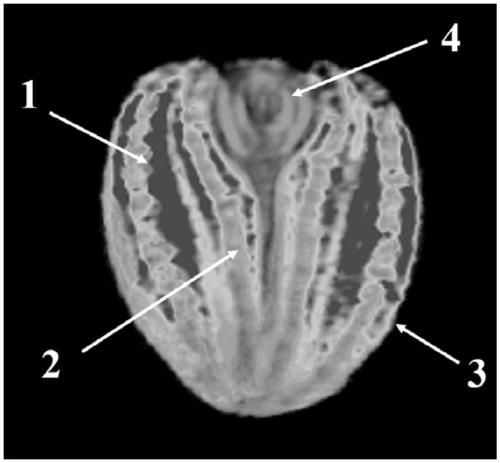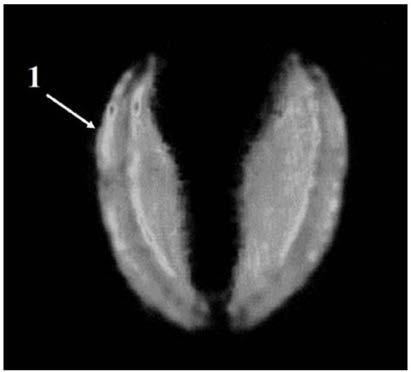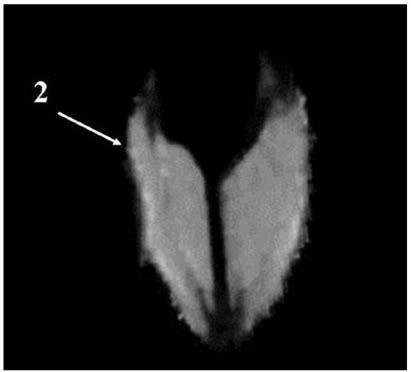Oil content gene locus specific to tissue part of rapeseed and application thereof
A gene locus and oil content technology, which is applied in the field of molecular biology and genetic breeding, can solve the problem of not being able to obtain the gene locus of oil content, and achieve the effect of improving oil distribution and clear position
- Summary
- Abstract
- Description
- Claims
- Application Information
AI Technical Summary
Problems solved by technology
Method used
Image
Examples
Embodiment 1
[0021] Example 1: Construction of a mapping population and linkage map for the oil content of Brassica napus
[0022] With N53-2 as the female parent and Ken C8 as the male parent, the F1 generation obtained by artificial emasculation and hybridization was planted in the field for microspore culture. More than 500 DH strains were successfully obtained, and finally 348 strains with good growth conditions were selected to construct a mapping population and named the KN DH population. This work was completed by the cooperative unit Shaanxi Hybrid Rape Research Center.
[0023] The total DNA of the population and parents was extracted using an improved CTAB method (for the extraction method, see Li Jia et al., an effective method for extracting total DNA from rape leaves, Journal of Huazhong Agricultural University, 1994, 13(5):521-523).
[0024] In the experiment, the rapeseed 60K chip was used to classify the population. In addition, some SSR, SRAP and STS molecular markers from publ...
Embodiment 2
[0030] Example 2: Obtaining the oil content data of each tissue part of the parent and DH population seeds
[0031] The instrument is a liquid nuclear magnetic resonance micro-imaging spectrometer Avance III 500WB, provided by Swiss Bruker.
[0032] The principle of nuclear magnetic resonance imaging is to use the characteristics of the spin motion of hydrogen atoms. In an external magnetic field, signals are generated after being excited by radio frequency pulses, which are detected by a detector and input to a computer. After processing, the image is displayed on the screen. Based on this principle, we can specifically perform quantitative imaging of the oil distribution inside rape seeds.
[0033] After each batch of seeds is used for imaging, the imaging data is imported into Amira 5.4.0 software for subsequent data processing. The basic process includes three-dimensional scanning of population seeds containing a total of 202 materials from two parents through MRI technology, th...
Embodiment 3
[0037] Example 3: QTL detection of oil content in each tissue part of seeds
[0038] Integrate the genotype data of the DH population and the phenotype data of the oil content of each tissue site to analyze the oil content of each tissue site respectively. QTL analysis was performed by Windows QTL Cartographer 2.5, using the method of composite interval mapping (CIM). QTL statistics are determined by the common logarithm of the maximum likelihood function ratio (LOD) and the percentage of phenotypic variation explained by each QTL. The QTL threshold was determined by a repeated sampling of 1000 permutation tests, and the significance level was set at 0.05. The QTL whose LOD value is above the threshold is called a significant QTL, and we call it an identified QTL. Subsequently, the detected QTLs of various tissues were integrated through meta-analysis through Biomercator 2.1 software. If there is no overlap in the QTL controlling the oil content of each tissue, it is regarded ...
PUM
 Login to View More
Login to View More Abstract
Description
Claims
Application Information
 Login to View More
Login to View More - R&D
- Intellectual Property
- Life Sciences
- Materials
- Tech Scout
- Unparalleled Data Quality
- Higher Quality Content
- 60% Fewer Hallucinations
Browse by: Latest US Patents, China's latest patents, Technical Efficacy Thesaurus, Application Domain, Technology Topic, Popular Technical Reports.
© 2025 PatSnap. All rights reserved.Legal|Privacy policy|Modern Slavery Act Transparency Statement|Sitemap|About US| Contact US: help@patsnap.com



